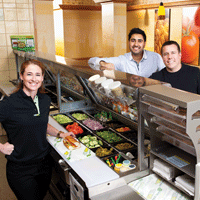The Subway story is one of American entrepreneurialism and whimsy. The chain that reaches from Singapore to San Francisco and Vancouver Island to St. John’s, N.L., began on a whim. A non-descript sub shop called Pete’s Super Submarines was opened in Bridgeport, Conn., in 1965 by high-school student Fred DeLuca, an aspiring doctor eager to earn money for medical school. The first store was funded by a $1,000 loan from family friend Peter Buck, a local nuclear physicist. Today, Doctor’s Associates Inc., (DAI) is based in Milford, Conn., and led by DeLuca, CEO.
The small business has grown to become Subway, and its reach has ballooned since 1965. “On a global basis, we closed the year by adding between 2,500 and 2,600 stores. Of those, about 1,100 were in the U.S. and Canada, with close to 200 in Canada. The rest are in the other 98 countries globally,” says Don Fertman, chief development officer, for Subway, who oversees global operations from Connecticut.
Given those figures, it’s no surprise Subway is the largest QSR in the world, measured by number of stores, with worldwide sales in 2011 of $16.6 billion, up from $15.2 billion in 2010 and $13.8 billion in 2009. “The economy has been quite good to us,” Fertman chuckles. “Our timing’s particularly good — not that we knew exactly where the economy was heading in 2008, but we came up with the $5-foot long at the same time the economy headed south. So the value proposition was the right thing, in the right place, at the right time,” he says. On Canadian soil, annual sales have been rising, too — from $1.2 million in 2009 to $1.4 million in 2010 and $1.5 million in 2011.
Subway is winning share in many countries, with a franchise system largely commandeered from the chain’s home base. Simply put: Subway restaurants and regional offices are independently owned, with each franchisee reporting to a regional development agent (DA), who reports to Subway’s world headquarters in Milford, Conn. The DA’s primary role is to build territory for the chain by finding new franchisees. Subway DAs meet with franchisees regularly and act as mentors, ensuring the tools and support are in place to make each store successful. In Canada, the country is broken down into 12 regions, by province and provincial communities; one of the larger regions is headed by Herman Grewal, president of OhCal Foods Canada, Subway’s development agency for southwestern Ontario and Niagara Falls (as well as Los Angeles and Orange County in California).
Grewal reports that the chain is strong in south-western Ontario. “Since we came, in [April 2009], we’ve had a sales increase of 26 per cent and traffic of over 31 per cent, so we’re gaining a lot of momentum,” he says. “We’ve built over 40 stores — we started off with 182, and we have about 226 in southwestern Ontario. In Ontario, I know we’re at 1,101 stores.” That amounts to approximately 38 per cent of the system’s 2,867-plus Canadian franchises.
For Fertman, solid business is the result of product and focus. “When you look at our menu, we have the health aspect, the fact that it’s better for you with fresh veggies, freshly baked bread,” says Fertman. “It’s low fat.” And, on the business side, Fertman keeps it simple. “We keep the overhead low, so our franchisees make the most profit out of every location,” he explains. “We focus on profitability and convenience for the customer. We keep it simple — no cooking, no frying, and we have a very flexible footprint as a result, so we can put a Subway store just about anywhere,” he adds.
And, that model is known the world over. The ubiquitous company has innovated and introduced region-specific menus sensitive to local tastes across the globe. For example, in India, Subway opened its first vegetarian store to satisfy Hindu dietary preferences, offering subs with a blend of corn, peas and carrots in a mayo-based sauce. “And there’s the Aloo Patty sandwich, which features potato patties made with turmeric and a variety of herbs and spices,” says Les Winograd, PR specialist for Subway. In Russia, Subway features roasted pork and garlic sandwiches while halloumi cheese is a favourite in Saudi Arabia. Back in America, where classics such as the steak and cheese, or sweet onion chicken teriyaki sell briskly, the American Heart Association’s Heart Check insignia appears on menus, signifying the brand’s nutritional profile. In fact, Subway was the first fast-food brand permitted to use the logo in the U.S.
Regardless where they’re located, Subway franchisees must be engaged with the brand. “We’re not too keen on investors investing, because we know people have to be in the stores to make them work, to deter theft and things like that,” Grewal says. Typically a franchise costs $15,000 for a new store. Start-up costs in Grewal’s southwestern Ontario territory are approximately $80,000 to $100,000, and the equipment is on par. (see “Numbers Game” on p. 18 for more details).
Franchisees are pleased with the chain’s approach. Doc Butler, one of Subway’s first Canadian franchisees, bought a store in St. John’s, N.L., in 1987 and looks back fondly on his Subway business. “It was a fun exciting time,” he says recalling the early days on Water Street in St. John’s. Today, his daughter owns a store that’s among the top 15 high-volume stores in Canada. While he can’t remember the exact figure, he says annual sales in 1987 were fairly modest. “It was under $200,000 [annually]. My daughter’s store does almost that in a month.”
Success stories abound in the Subway fold, as evidenced by franchisee Jacquie Gregg’s string of London, Ont.-based stores. “Doctors Associates, our franchisor, has done a great job,” says Gregg, who owns five franchises in London, Ont., with her husband, Todd. “We’ve been the number-1 franchise for the past 15 years. Our national and local advertising is one of the keys to our success.” The Greggs enjoy their relationship with DAI and like the fact that franchisees own and operate an independent purchasing co-op, which allows them to buy food at the best prices. And, it helps that she has a good relationship with Grewal, her development agent. “Herman and his team are very motivating and thorough. It’s a complete pleasure to work with them,” she says.
But, aside from running a booming business, the chain also gives back, partnering with the Toronto-based Participaction — a Canadian fitness not-for-profit — to sponsor the organization’s annual sports day in Canada. Commit to Fit is Subway’s exclusive event motivating Canadians to make healthy lifestyle choices. For example, The Cape Breton Screaming Eagles Steps-for-Health school program promotes balanced eating, physical fitness and rest, while the Pedal-for-Hope cycling team in Peterborough, Ont., supports the Canadian Cancer Society. Meanwhile, Montreal-based Subway franchisees have supplied hundreds of sandwiches and cookies to a local soup kitchen for the past two years.
As for the future, Subway is undergoing a refresh. “I’m excited about the new concept we’ve been working on, upgrading our decor,” says Grewal. “It’s more of an upscale look, so a lot of the new-builds and remodels we’ll be building in 2013 and 2014 will have the new decor.” The concept was designed to offer a more inviting dining experience. “Flooring has changed, the seating is more contemporary, there’s a nice stone wall,” explains Grewal. Several Toronto stores have already been rejuvenated.
But, redesign or not, Gregg is excited about working on the Subway team. “After 21 years,” says Gregg, who’s now building her sixth Subway store, “I can honestly say I love my work. With the help of excellent managers, incredible staff and a supportive family and DAI, I am always motivated to excel and open more locations.”





















